The CAP express liners of HAMBURG-SÜD, CAP FINISTERRE, CAP TRAFALGAR, CAP POLONIO and CAP ARCONA, are known worldwide for their luxury, renowned service on board and grandeur. Their successors of the 60s, the CAP SAN vessels, have not been that elegant, but truly first class and were known as the "White Swans" of the Atlantic.
by Earl of Cruise
HAMBURG-SÜD´s SANTA TERESA in Santos - courtesy HAMBURG-SÜD
Since its formation in 1871, HAMBURG-SÜDAMERIKANISCHE DAMPFSCHIFFFAHRTS-GESELLSCHAFT (HSDG or HAMBURG-SÜD) has evolved from a conventional freight and passenger shipping company into a global operating transport logistics organisation. Today, it ranks among the world's ten largest container shipping lines and is one of the leading providers in the North-South trades. Till recently it was a member of the successful Oetker Group, one of the largest and best-known family enterprises in Germany. The heirs and owners sold HAMBURG-SÜD to the Danish MAERSK Group, the world largest container shipping entity in the world. The companies name and headquarter in Hamburg will remain as is.Over the years HAMBURG-SÜD had some corporate takeovers accomplished, and now owns Brazilian operator Aliança and Spanish operator Ybarra Sud. It has taken over many companies over the years including Ellerman, Kien Hung, South Seas Steamship, Deutsche-Nah-Ost-Linie, Royal Mail Line, Pacific Steam Navigation Company, Swedish Laser Lines, Rotterdam Zuid-America Lijn, Havenlijn and the Inter-America services of Crowley American Transport. In the past parts of HAMBURG-SÜD have been known as Columbus Line. Since 2004 the services of COLUMBUS LINIE are directly integrated into HAMBURG-SÜD. The current container fleet of dry boxes has a distinctive red colour with a huge flag and white HAMBURG-SÜD logo on the side.
The BeginningIn 1871 the beginning was somewhat peculiar. But the then founders had been driven by the enthusiasm of the new Kaisereich der Deutschen. Following a capital increase for HAMBURG-BRASILIANISCHE DAMPFSCHIFFAHRTS-GESELLSCHAFT, existing since 1869, HAMBURG-SÜD emerged as a successor company. In total eleven parties or partners had been involved. Heinrich Amsinck (1824–1883) became the first president of the newly formed HAMBURG-SÜD.
The new company started with the three 4,000 BRT (GT) big vessels of HAMBURG-BRASILIANISCHE DAMPFSCHIFFAHRTS-GESELLSCHAFT and bought a fourth for the liner service to Brazil and later Argentina. From 1873 onwards the first newbuilds for the service arrived. Also in October 1873 the first German built vessel for HAMBURG-SÜD arrived, the 2,247 BRT (GT) VALPAREISO, of Reiherstiegwerft.
HAMBURG-SÜD had strong competiors on the South Atlantic route of which some had been heavily subsidised, such as the ROYAL MAIL LINE. But with NORDDEUTSCHER LLOYD 1875 came a new fierce competitor from their own country. Later it was another one from Hamburg, the A.C. de FREITAS & Co.
1881 followed Ferdinand Laeisz (1801–1887), but 1885 succeded by his son Carl Laeisz (1828-1901). Till 1885 HAMBURG-SÜD had a fleet of 16 steamers totalling 30,000 BRT (GT).
In 1890 the AMAZONAS the first steamer above 3,000 BRT (GT) arrived, and 1895 with the type vessel ASUNCION with 4,663 BRT (GT) of BLOHM&VOSS. It was a series of 11 ships in total built by Blohm&Voss and Reiherstieg in Hamburg till 1899. With these 11kts vessels, HAMBURG-SÜD got a more competitive position against ROYAL MAIL LINES, PACIFIC STEAM NAVIGATION COMPANY and 14 further competitors. Seven British, three French, three Italian, one Spanish and two German lines offered their South America routes and services.
While the British lines had been heavily subsidised and could afford 13,000 BRT (GT), 21kts steamers, HAMBURG-SÜD was far from its later fame. The company stood at the threshold to become a freight only line.
Rising to the Top
HAMBURG-SÜD wanted to gain a better position in the passenger traffic to South America for which the ASUNCION class had been no competition. The French, British and Italian ships had been far bigger, faster and much more comfortable.
1900 was a year of change.
At first HAMBURG-AMERIKANISCHE PACKETFAHRT-ACTIEN-GESELLSCHAFT (HAPAG or HAMBURG AMERICA LINE) bought the 14 de FREITAS vessels and started its own South America service. With this purchase the fierce competition with de FREITAS ended. HAMBURG-SÜD came to a joint service arrangement with Albert Ballin, in which HAPAG hold 1/3 and HAMBURG-SÜD the other 2/3. It was possible, as Albert Ballin had the aim to live and let live.
In the same year, the first of nine CAP express steamers arrived. The nine vessels,
delivered up until 1914, had been the biggest steamers for HAMBURG-SÜD on the South America route. Besides these steamers served the first class passengers with extraordinary luxurious cabins and salons. Passengers knew about the luxuries offerd on liners on the Transatlantic route, and expected the same level on other routes as well. These new liners had a yellow funnel which distinguished them from the rest of the fleet with their black funnels.
RAOUL SOARES, ex CAP VERDE - Source:
Wikipedia
CAP FRIO - 5,732 BRT (GT) - CAP ROCA - 5,786 BRT (GT), 12862 x 14,7 x 8,84m, 2,900 hp, 80 I. - 500 III. class passengers, 84 crew - CAP VERDE - 5,909 BRT (GT), 129,54 x 14,72 x 8,87m, IV expansion, 3,000 hp, 11,5/12,5kts, 87 I. - 500 III. class passengers, 84 crew, 1900The three liners were all inaugurated in 1900.
CAP FRIO
After inaugurating on the La Plata route in March 1900, the vessel was charterd to HAPAG for its New York route until February 1901. And sailed till its stranding at the Barra lighthouse, near Bahia, in Aug. 30th 1908 further on the La Plata route.
CAP ROCCAInaugurated in June 26th 1900 and sailed till the outbreak of WWI on the La Plata route. CAP ROCCA was laid up in Rio de Janeiro and then seized on June 1st 1917.
From 1918 to 1926 she sailed as the LLOYD BRASILEIRO liner ITU, and was renamed ALMIRANTE ALEXANDRINO for LLOYD BRASILEIRO. In 1966 she was finally scrapped.
CAP VERDE
In August 1900 the CAP VERDE inaugurated on the La Plata route, and was laid up in Hamburg in August 1914. The SHIPPING CONTROLLER, London, took the vessel as
reparation in March 1921. She was sold to ANGLO-YUGOSLAV, but never sailed for, and was bought back by HAMBURG-SÜD on May 20th 1922 and renamed MADEIRA, since its selling to LLOYD BRASILEIRO in July 1925. As RAUL SOARES she sailed till Nov. 1965, when she was sold for scrapping in Rio de Janeiro.
CAP ORTEGAL - Source:
Wikipedia
CAP BLANCO - CAP ORTEGAL - 7,819 BRT (GT), 134,36 x 15,96 x 9,06m, 2 III expansion, 4,200 hp, 13,5kts, 164 I. - 96 II. - 338 III. class passengers, 130 crew, 1904These liners all began in 1904 on the La Plata route.
CAP BLANCO
From April 1904 till August 1914 she sailed on her intended route to South America, and was laid up during WWI in Hamburg, after her selling to HAPAG, and renaming PRINZ HUBERTUS for the East Asia service of Albert Ballins line. On April 2nd 1919 the
SHIPPING CONTROLLER took possession. But on Nov. 23rd 1919 the vessel caught fire and became a total loss. In Nov. 1920 she was sold for scrap to FALMOUTH DOCK Co., but finally broken up in 1923 in Hamburg.
CAP ORTEGAL
From May 1904 till her lay up in Teneriffe in Aug. 1914, she sailed on the La Plata route. In Nov. 1912 the vessel rescued the crew of the sinking British freighter BARCELONA in the Bay of Biscay. She was intended to sail as PRINZ WILHELM for HAPAG to East Asia from Aug. 1914 onwards. May 25th 1919 she was given to the French Government, and sailed from 1923 till her scrapping in 1932, in La Seyne, for MESSAGERIES MARITIMES as their CHAMBORD.In the early second half of the first decade of the 20th century, enlarged versions of the first five new liners set sail. They would be faster and offered more luxuries for their first class passengers.
The two newbuilts sailed right into one of the fiercest shipping and economy crises the modern world has seen after the Wiener Börsenkrach in 1872. Freight rates declined as well as the most lucrative first class passenger numbers. The costs for maintenance, coal, supplies, etc. rose enormously, while stikes in ports of embarkation hindered the delivery of goods and disembarkation of passengers.
Despite the crisis and the competition of the heavily subsidised competitors, HAMBURG-SÜD was able paying a revenue to its shareholders.
CAP VILANO - Source:
Wikipedia
CAP VILANO - 9,467 BRT (GT), 144,99 x 16,84 x 9,41m, 2 IV expansion, 6,200 hp, 15kts, 200 I. - 98 II. - 302 III. class passengers, 166 crew, 1906The vessel sailed from Aug. 25th 1906 till Aug. 4th 1914 for HAMBURG-SÜD, when she was laid up in Pernambuco. June 1st 1917 she was seized by Brazil. Her name changed to SOBRAL, but was handed over to MESSAGERIES MARITIMES in 1924 and had been renamed as GÉNERAL METZIGER. On June 11th 1940 she was sunk by the Luftwaffe in Le Havre, while anchored offshore.
CAP ARCONA, 1910 - Source: Wikipedia
CAP ARCONA - 9,832 BRT (GT), 147,26 x 16,92 x 9,41m, 2 IV expansion, 7,600 hp, 15kts, 244 I. - 110 II. - 404 III. class passengers, 176 crew, 1907The first vessel of HAMBURG-SÜD to bear this name, sailed September 15th 1907 for the first time to the La Plata, till her lay up Aug. 4th 1914 in Villagarcia. On May 31st 1919 CAP ARCONA was handed over to the French Government. Since Nov. 21st 1923 she sailed as ANGERS for MESSAGERIES MARITIMES till 1939, when she was scrapped in La Seyne.
The Queens of the South Atlantic
In 1911 HAMBURG-SÜD was transporting over 60,000 passengers on the routes to Brazil. This year was also the starting point for the rise of the most important shipping line in the South America trade.
With the first CAP class vessel the service of HAMBURG-SÜD was split more and more into the mail and passenger service, and transportation of goods on different types of ships. This dividion was more or less finalized with the appearance of the first real liner for HAMBURG-SÜD.
In 1911 inaugurated the first real liner for HAMBURG-SÜD. It was the first real `Schnelldampfer´ of the company. And this liner was the first to compete - similar in speed, but more luxurious - with the new South America liners of ROYAL MAIL LINE and other competitors. Further it was the first liner for the company which had two funnels. BLOHM&VOSS, Hamburg, delivered the liner which should become the biggest, the fastest and most comfortable on the South America route - CAP FINISTERRE.
CAP FINISTERRE - Source: ibiblio.org
CAP FINISTERRE - 14,503 BRT (GT), 180,14 x 19,89 x 9,52m, 2 IV expansion, 10,600 hp, 16,5 kts, 297 I. - 222 II. - 870 III. class passengers, 339 crew, 1911315 first class passengers could sit in one sitting in the Speisesaal (dining room). The height of this room reached over two decks. Above which was the Wintergarten, with a glass ceiling. The first class passengers also had a Smoking Salon, a Gymnasium, a Writing Room, a Café, a Childrens' Room with playground and an elevator. A special treat for the passengers had been the swimming pool on the boat deck. This was the first outdoor pool on any liner, after the
first indoor pool on board the rms OLYMPIC.
The installation on the boat deck was a real challenge for the engineers in early 20th century.
The interior architect Emil R. Janda was responsible for the design, while the craftsmen of CARL FRIESE, Kiel, realised the outfitting.
For the comfort and security CAP FINISTERRE got a FRAHM antiroling system.
CAP FINISTERRE was setting the standard on the route to the port of La Plata and South America.
On November 21st 1911 the CAP FINISTERRE set sail for the La Plata from Cuxhaven, Steubenhöft, back then a territory of the Freie Hansestadt Hamburg. She sailed till August 1914 on the route, and was laid up in Hamburg during WWI. April 4th 1919 she was handed over to the United States, which transferred her into a trooper some days later. November 25th she was handed over to the SHIPPING CONTROLLER, London and again to Japan in 1920. In 1921 she became the TAIYO MARU for TOYO KISEN, Tokyo. 1926 she was transfered to NIPPON YUSEN KAISHA, Tokyo and sailed on their Pacific route to the USA. On May 8th 1942 she was torpedoed south-western off Kyushu by the US Navy submarine GRENADIER.
TAIYO MARU, ex CAP FINISTERRE - postcard, copy, own collection
While setting the benchmark for the competitors on the South America route, the same competitors had to answer, if they would not fall behind the new vessel, reigning the La Plata route. HAMBURG-SÜD therefore immediately ordered a new, bigger and more comfortable vessel for its fleet, to stay on top of the competition.In 1912 HAMBURG-SÜD has seen the highest passenger numbers ever on their South America route. And a rise of numbers was expected by all participaints.
The market competitors all have taken the challenge of HAMBURG-SÜD and ordered ships of around 14,000 GT. So the KONINKLIJKE HOLLANDSCHE LLOYD with two 14,000 GT vessels of 17,5kts. And the French COMPAGNIE de NAVIGATION SUD-ATLANTIQUE was sending the BURDIGALA en route to the La Plata ports. It was like a loud beating, as the vessel was capable of 20kts - the former KAISER FRIEDRICH. And a contract for constructing three 15,000 GT vessels with 20kts had been signed.
BURDIGALA, ex KAISER FRIEDRICH - Source: Wikipedia
CAP TRAFALGAR - 18,710 BRT (GT), 186 x 21,9 x 8,5m, 2 II expansion combined with steam exhaust turbine, 15,000 hp, 17 kts, 394 I. + 62interchange - 140 II. - 134 III. - 912 IV. class passengers. 436 crew, 1914
CAP TRAFALGAR - own collection
The triple screw liner had a triple-expansion steam engine combined with a steam-exhaust turbine.March 3rd 1914 the liner set sail from Hamburg to the La Plata. CAP TRAFALGAR had a short career on the route as the most luxurious mail and passenger liner to South America.
Travelposter of HAMBURG-SÜD depicting CAP TRAFALGAR - copy, own collection
The board of directors thought the speed competitive enough, but the benchmark for the passenger accommodation was rising again. With the introduction of CAP TRAFALGAR the appearance of the fleet changed - former black funnels for the freighters and lower standard passenger vessels and the yellow for the express liners changed to white with a red top.Blinded by imperialism and over-estimation in 1914 all powers went into WWI as if it was an afternoon walk or an Easter parade.
It turned out to be the first catastrophy of 20th century.
With Armistice in 1918, the world was a different one from 1914.
The KAISERLICHE MARINE requisitioned the liner while en route. All passengers and non military crew of CAP TRAFALGAR had been disembarked in Montevideo, and CAP TRAFALGAR became a ship of the German KAISERLICHE MARINE, an auxilliary cruiser - smhk CAP TRAFALGAR.
In August 1914 the gunboat sms EBER of the German KAISERLICHE MARINE, supported by the HAPAG steamer PONTOS, 5,703 BRT, and the liner ELEONORE WOERMANN, WOERMANN LINIE, 4,624 BRT, helped to transform the liner into an auxilliary cruiser off coast the Brazilian Ilha da Trinidade. The KAISERLICHE MARINE had installed a depot on the island for all eventuallities ...
The transforming had been done in a kind of rush and was more or less inefficient.
As it was common sense within all admiralities - passenger liners had been seen as valuable support of their navy. As other passenger liners, including the KAISER WILHELM DER GROSSE, the new CAP TRAFALGAR was lightly armed with two 10.5 cm guns and six heavy machine guns. She lost her third funnel, and was disguised by painting as a British liner.
smhk CAP TRAFALGAR and hms CARMANIA fighting - Source: Wikipedia
(smhk: Seiner Majestät Hilfskreuzer)
700 miles east of the Brazilian mainland coast, during transformation at Ilha da Trinidade, CAP TRAFALGAR encountered the fully armed British steamer CARMANIA. While refuelling at Ilha da Trinidade, the collier ELEONORE WOERMANN dashed away, as of no help for the coming battle. 09:30 a.m., September 14th 1914, CARMANIA and CAP TRAFALGAR started to exchange fire.CARMANIA was heavily damaged, burning, water in the ship and listing severly, but CAP TRAFALGAR was fatally wounded, with several watertight compartments taking water.
CAP TRAFALGAR began listing to starboard and sank bow first, taking 51 lives, including Captain Wirth.
The distress calls, coded, did reach another German auxilliary cruiser, the smhk KRONPRINZ WILHELM. She reached the scene seemingly to provide the coup de grace for CARMANIA , but the commander, Kapitän von Niezychowski, feared a British trap and turned away without firing a single shot. (Von Niezychowski, 1928)
While CARMANIA limped into Pernambuco, ELEONORE WOERMANN rescued the survivors and sailed to Buenos Aires. Most of the survivors had been interned for the rest of the war on Martín García Island.
This battle, and the early loss of KAISER WILHELM DER GROSSE, showed all admiralities of the war parties the uselessness of liners as war ships. But the liners hadn´t been laid up and waiting for the peace to come. They got transformed into troopers or hospital ships and became more useful as such, than as auxilliary cruisers. And these troopers helped in WWI transferring armies across the oceans.
When the murder in Sarajewo happened in August 1914, and the mechanisms of war started, the fleet of HAMBURG-SÜD consisted of 56 vessels with 325,031 BRT (GT), 41 of these ships with 240,993 BRT (GT) had been passenger vessels. And CAP POLONIO, at 20,000 GT plus, and further three small freighters had been under construction. This made HAMBURG-SÜD the number four within the biggest German shipping companies. The chain reaction after Sarajewo changed everything.
WWI ended all civilian activities at sea, world wide. And in the aftermath of it the civilian service started slow, as each seafaring nation had to rebuild its fleets and cover the war losses. Shortages of steel and workhands was another problem. So seiziure of the German merchant fleet came handy, and after war duties for war repatriations and troopers the vessels got careers with the victors of the war.
Deliberately the Aliies threatened Germany with the continuation of the war, if Germany would not sign the dictated treaty. And that war was fought, to end all wars in the future ...
But Versailles laid the seed for the next war.
Those ships which had not been seized or sunk by the Allied forces, had be handed over to the Allies as the treaty of Versailles finally dictated. It was dicated months earlier with the Shipping Treaty of Trier.
HAMBURG-SÜD was deprived of all ships, except one the JACUCHY, 5,745 BRT (GT). She was finished in 1920 with accommodation for 585 passengers. ARGENTINA, as she was named now, set sail on December 1920 for her inaugural voyage to South America, and was the first German passenger vessel newbuilt after WWI. This provisional trip became a tremendous success. Her voyage seemed to be a triumphant march. Each port of embarkation made a fantastic welcome party for the small liner. When she finally reached Buenos Aires, it became a carnival - phoenix rising from the ashes.
The Age of the Express Liners
CAP POLONIO - 20.567 BRT (GT), 201,8 x 22,06 x 12,05m, 2 III expansion combined with steam exhaust turbine, 20,000 hp, 16,9kts - later 18,5kts, triple screw, 356 I. - 220 II. - 949 III. class passengers, 400 crew, sms VINETA, 1915, CAP POLONIO, 1916, 1919-21, 1922
Travelposter of HAMBURG-SÜD depicting the South-Atlantic route and CAP POLONIO - copy, own collection
CAP POLONIO got, as the first liner ever, Dr. Foerster sponsons in the waterline to increase her stability. Other liners got fixed ballast and had to use a ballast water system, which was and is a difficult system when combined.
CAP POLONIO calling in Rio de Janeiro - own collection
With the outbreak of WWI the construction works for CAP POLONIO immediately halted. But driven by the idea to have another suitable auxilliary cruiser, the German admirality seized the vessel and heavily rebuild her as the auxuilliary cruiser VINETA. On her trials it was discovered that the furnesses did not deliver enough steam power, and the speed ended with 16kts, instead of estimated 19kts. The KAISERLICHE MARINE handed the vessel disapointedly back to the builder and HAMBURG-SÜD. The REICHSTAG ordered the builder for the immediate rebuilding of the VINETA into the CAP POLONIO. 1916 the vessel turned, despite her civilian role, into a weapon of propaganda. Germany displayed with the presentation of the finished CAP POLONIO, in the third year of the war, its strength, wealth and power to build in wartime a new passenger liner.The SHIPPING CONTROLLER handed the CAP POLONIO to P&O for their "England - Capetown" service, and the BREMEN to UNION-CASTLE for their "Australia service" - this was changed by the companies itself, not by the SHIPPING CONTROLLER.
June 21st 1921 the fully booked CAP POLONIO, no name change, sailed for UNION-CASTLE, finally, to Capetown and Durban. The vessel was the most luxurious this route had seen to that day. But the engineers of UNION-CASTLE suffered more than those of the KAISERLICHE MARINE back then, as they never got the engines to produce more than 12kts. The voyage took more time than anounced and the angry passengers had to change for another ship to sail for Durban. Despite her engine troubles, the vessel was again fully booked - eventually the passengers wanted to get a taste of the now legendary luxury of the vessel. Again CAP POLONIO reached Southampton in massive delay. UNION-CASTLE, extremely disappointed, handed the vessel back to the SHIPPING CONTROLLER.
The next candidate was P&O. At Davenport Dockyard engineers tried their best to fix the problems of the machinery. P&O send CAP POLONIO, this time in P&O colours and fully booked, because of her luxurious accomodations, to Bombay and snailed at 10kts, embarking in ports, never mentioned on the sailing schedule, to India. With a further massive delay she reached finally, again fully booked, the homeport of P&O.
Desperate, P&O handed the vessel back to the SHIPPING CONTROLLER, who did send her to SANDON DOCK for lay up and sale. But non of the British shipping lines showed interest in the most luxurious vessel offered, with a top speed of a mere of 10kts.
J.H.Isherwood, wrote his thesis in `STEAMERS of the PAST´, that BLOHM&VOSS had manipulated the engines, which could have taken place, just in 1915, as it was more than easy for BLOHM&VOSS in 1921 to fix the machine problems - an alibi could be the change to oil fiering ... but ... A prove for this speculation can not be found.
HAMBURG-SÜD bought back CAP POLONIO for US$ 150,000. Cheap, but expensive for HAMBURG-SÜD as the Inflation just started and 1 US$ was to buy for 500 Reichsmark back then - 75,000,000 Reichsmark.
CAP POLONIO was similar laid out as CAP TRAFALGAR, but topped her outfitting luxuries. For exmple the dining room had a hight of 5,60m, and only a balcony for the musicians.
Tugboats towed CAP POLONIO back to her builders. Two new boilers were added to the existing 15, and the fueling was changed to oil.
When Kommodore Ernst Rolin started the inaugural voyage to Buenos Aires, CAP POLINIO was not only the flagship of HAMBURG-SÜD, but of the German merchant fleet. She was by far the biggest and most luxurious on the La Plata route.
Similar to ARGENTINA, CAP POLONIO was greeted with enthusiasm in each port of embarkation, and was greeted in Buenos Aires with a carnivalesque welcoming.
For the next 5 years she was a single passenger liner of HAMBURG-SÜD on the route, but proved hugely popular. The whole "old money aristocracy" and the new rich, "war winners", of especially South America booked passages on the vessels like "ice cream". This attraction led to cruises into Terra del Fuego, with its glaciers and fjords. 1923 cruise route was added - Buenos Aires, via Rio de Janeiro to Santos and back. This proved to be equally popular as the Chilean cruise. And in 1926 a Trans Atlantic cruise to Europe was added. This three month cruise included Norway, the North Sea and the Baltic Sea, with a stop in Leningrad, and retour. In 1928 a Buenos Aires Caribbean Cruise was added, were she anchored for a first in New York. 1930 a single cruise was organized from Buenos Aires into the Mediterranean.
Known to the world as THE luxury cruise ship, CAP POLINIO was only beaten by COLUMBUS, 32,354 BRT (GT) of NORDDEUTSCHER LLOYD. But they proved to be equals.
LUTETIA of SUD-ATLANTIQUE - Source: Wikipedia
CAP POLONIO was only to be beaten in speed on the La Plata route by the French LUTETIA. The advent of GUILIO CESARE, 21, 848 BRT (GT) made a single, and her first voyage, to Buenos Aires - it was a gesture of prestige, orderd by the Duce.
GIULIO CESARE in ITALIA S.p.A. colours - own colection
In 1926 and ´27 two new 22,000 GT ROYAL MAIL motor ships appeared on the route, and CAP POLONIO no longer was the biggest ship to South America, but still the most luxurious.The final dethronement came from HAMBURG-SÜD itself in 1927, when CAP ARCONA set sail for her inaugural voyage to Buenos Aires.
1922 two smaller newbuilds for HAMBURG-Süd set sail to South America too. The sisters ANTONIO DELFINO and CAP NORTE. They had been far from glamurous, but "sound working horses".
ANTONIO DELFINO as SIERRA NEVADA for the LLOYD in the Kaiserschleuse in Bremerhaven, Columbus Kaje with EUROPA - Source: Wikipedia
ANTONIO DELFINO - 13,502 BRT (GT), 160,4 x 19,52 x11,79 m, 5 cyl. III expansion steam engine, 6,300 hp, 13kts, 184 I. - 334 III. class passengers, 211 crewInaugurating March 16th 1922 on the La Plata trade, she got steam exhaust turbines installed to increase her speed to 15kts. 1932 till ´34 she chartered to NORDDEUTSCHER LLOYD as their SIERRA NEVADA. She reached Hamburg on April 5th 1940 after escaping from Bahia. In April she became a troop barracks for the KRIEGSMARINE. and was used as army hospital ship from March 1945 till the end of WWII. ANTONIO DELFINO was handed over to the MINISTRY of TRANSPORT in October 1945. and was transformed into the troopship EMPIRE HALLADALE. February 1st 1956 she reached Dulmuir for scrapping.
CAP NORTE - 13,615 BRT (GT), 160,4 x 19,52 x11,79 m, 5 cyl. III expansion steam engine, 6,300 hp, 13kts, 184 I. - 334 III. class passengers, 211 crew
She inaugurated on September 14th 1922 on the route to Buenos Aires. She too got steam exhaust turbines installed and reached a speed of of 15kts . From 1932 till ´34 she was chartered by NORDDEUTSCHER LLOYD and sailed as their SIERRA SALVADA. While escaping from Pernambuco to Hamburg she was captured October 9th 1939 by the ROYAL NAVY cruiser BELFAST, which is now moored in London, seized and rebuild as the troopship EMPIRE TROOPER. In May 1955 she reached Inverkeithing for scrapping.
From 1922 to 1927 CAP POLONIO was a single within the HAMBURG-SÜD fleet. When the CAP ARCONA entered the fleet, she was finally dethroned as the Queen of the South Atlantic. Both liners served the La Plata route, but with CAP POLONIO more often cruising than doing liner voyages.
When in October 1929 the World Economic crisis hit, the aging CAP POLONIO was withdrawn in 1930 and massivley rebuild, as the board thought of a short crisis ... March 11th 1931 she returned to her old duty as liner, with a similar standard as her new fleetmate, but laid up the same year. A planned cruise in September 1932, out of Southampton, was blocked by British shipowners, and laid up again.
In 1933 she was used as floating fair for the German industry till her lay up again the same year. Finally June 21st 1935 CAP POLONIO was sold to M.STERN AG, Essen, for scrap.
A hotelowner bought furniture and fittings as well the outfitting of the dining room for his new hotel in Pinneberg, which he named HOTEL CAP POLONIO. The hotel and the dining room is still existing and well preserd, as well the history of CAP POLONIO.
Blue prints for KdF and modern day cruises
The MONTE class ships of HAMBURG-SÜD had been the first passenger liners with diesel engines for the company. They all had the same dimensions of 159,7 x 20,05 x 11,55m, 1,328 to 1,354 II. - 1,142 to 1,156 III. class passengers, 280 crew, and similar interrior lay out. But each vessel had different measurements
MONTE SARMIENTO the type vessel of a series of for HAMBURG-SÜD - Bundesarchiv, Source: Wikipedia
MONTE SARMIENTO, 13,625 BRT (GT) - 1924, MONTE OLIVIA, 13,750 BRT (GT) - 1925, MONTE CERVANTES, 13,913 BRT (GT), 1928 - MONTE ROSA, 13,870 BRT (GT) - MONTE PASCOAL - 13,882 BRT GT), 1931, the last two had only II. class accommodations for 2,408 passengers and 253 crew.The MONTE class became popular amoung the III. class travellers and had been successful, but the emigrant trade to South America did not reach the expected peak, for which the vessels primarily had been built for.
When MONTE SARMIENTO entered the market, she was the biggest motorship ever build to that time.
While HAMBURG-SÜD offered first class cruisers for the truly rich on board their CAP POLONIO, the company also developed the mass market cruises on board the MONTE class ships, and had been too successful with this new venture.
These budget cruises had been copied by the fascists in Italy, and well perfectioned by the German NSdAP and their Nazi organisation KdF (Kraft durch Freude). They took the "state organized" cruise idea from Italy. What started as a real joy for the lower income people, was then created to bribe the working class and gain their minds for the Nazi party.
The same cruise structure of HAMBURG-SÜD is used today for the mass market cruise offers - today far more elaborated and developed than in the very beginning with the MONTE class. Even the lay out of the MONTE vessels had been transfered into the own KdF purpose built WILHELM GUSTLOFF and ROBERT LEY. And their lay out is finally the Blue Print of modern day cruise vessels.
The Queen of the South Atlantic - CAP ARCONA
CAP ARCONA sailing the South Atlantic - courtesy colouring Daryl LeBlanc
CAP ARCONA - 27,561 BRT (GT), 205,9 x 25,78 x 12,78 m, 2 B&W turbines, 28,000hp, 21kts, 575 I. - 275 II. - 465 III. class passengers, 630 crew
While HAMBURG-Süd did well, even if still rebuilding its fleet, the decision was made to build a new top ship for the Buenos Aires route. The competitors moves with new vessels made the decision for this costly risk "easy". It had but these top outfitted liners been which gave HAMBURG-SÜD its foremost position in the market.
CAP ARCONA layout - own collection
It was like the quadrature of the circle that the new liner had to fulfill - vast numbers of outside cabins with the highest quantity of en-suite facilities (262 of 379 cabins, including 117 single cabins inside), same interior, low draft, maximum fuel capacity - bunkering only in Hamburg, fast, and luxurious salons. The result was the CAP ARCONA.
CAP ARCONA, well known photography, depicting the Queen of the South Atlantic in Buenos Aires - own collection
Her interior style was defined by architect H.E. Mieritz, Berlin, and C.FRIESE was responsible for the outfittings.CAP ARCONA was outfitted with swimming pool - indoor / H Deck, Wintergarten, gymnasium, real tennis court, shopping mall - including a flowershop, tailor, craftsmanshop for shoes, elevators, laundry, printing studio, dog kennel including waiters, state-of-the-art hospital, telephones, etc. The dining room (5,5m in height, 630m²) was positioned aft and had 20 windows on its three sides. To get shade in the tropics, canopies could be lowered to prevent the sun's heat.
November 19th 1927 CAP ARCONA set sail for her first voyage to Brazil, including Rio de Janeiro, Uruguay and Argentina - Buenos Aires. With her speed of 20kts she reached Rio in 12 days, and Buenos Aires within 15. This voyage became a triumph, similar to that of CAP POLONIO five years earlier.
CAP ARCONA First CLass cabins - all the four above pictures are copies from a promotion broshure of HAMBURG-SÜD
Her only rival was the now biggest motorship of the world, the AUGUSTUS, which sailed till 1928 on the same route, tomake the tragic sinking of the PRINCIPESSA MAFALDA forgotten. Only from 1928 to September 1931 CAP ARCONA was unrivalled.
What the board of HAMBURG-SÜD had expected when ordering the new liner, fierce and rivaling competition, became reality when L´ATLANTIQUE, 40,945 BRT (GT) on the route appeared.
She was a real challenge, as she was more luxurious, bigger and even faster than the Queen from Hamburg.
But when L´ATLANTIQUE was gone, in 1933, ITALIA S.p.A. - merged from three Italian lines, was sending their AUGUSTUS, again, and the ROMA on the La Plata route. But despite her competitors, CAP ARCONA was still loved and preferred by the South American society. In a society with hard standards it was a must to sail on her, and to be accepted by the others.
CAP ARCONA, Salon
CAP ARCONA, the Wintergarten
CAP ARCONA, the Swimming Pool
CAP ARCONA, the hospital
all photographies are copies from a HAMBURG-SÜD promotion broshure of the mid/late 30s
In 1936 the dormitories of III. class on G Deck had been removed and remodeled into cooled freight rooms, which earned more revenue.The roundtrip from Hamburg to La Plata and back was sold for RM 1,980 I. class, and for Rio de Janeiro for RM 1,810 in I. class.
CAP ARCONA took over the cruises of CAP POLONIO from 1930 and did well.
With her 92th voyage, with the return trip starting on August 7th 1939, CAP ARCONA´s last voyage did begin, and with that the passenger liner trade in grand style for HAMBURG-SÜD.
Again the world turned into an inferno - WWII started with the German invasion in Poland. The lights went off, the world did fall apart. This war, caused by the meanest emotions, and bringing the darkest of mankind to light, was apocalyptic, as was the end of CAP ARCONA.
In 1940 the CAP ARCONA, initially one of the most beautiful passenger liner in its time, was converted to serve the KRIEGSMARINE as an accommodation vessel - 2,000 in total. 1941 CAP ARCONA escaped her end after an explosion in the machine room, which ignited an oil storage.
In 1942 TOBIS FILM GmbH, second largest film producer in Germany back then, produced a propaganda film on board the vessel - `TITANIC´, directed by Herbert Selpin. This chauvinistic film was based on the novel of Pelz von Felinau, published 1939. The film was anti British and of mean acting. But the same trick sequence of the sinking of TITANIC was that elaborated, that it was used again 1958 in the British production `A Night to Remember´.
But depicting CAP ARCONA as the "Nazi TITANIC", because of this 3rd class propaganda film, is chauvinistic in itself.
The director of the film ended up in a Gestapo jail and died, and his "film" was forbidden in 1943 by the failed 3rd classjournalist Goebbels himslf.
CAP ARCONA, after five years of lay up, was then commandeered as one of the rescue ships for the too late beginning of the eastern provinces (Gaue) of Germany. January 31st 1945 she sailed from Gotenhafen/Gdynia into the west with 10,000 refugees on board.
She was send to the port of Neustadt/Holstein, in the Bay of Neustadt, part of the greater Lübeck Bay, as there was no fuel to get, sending CAP ARCONA back into the east for further evacuations. From February till end of APril the SS tried to get hold of CAP ARCONA as a jail ship for his concentration camp victims. They succeded and send April 26th the first 4,500 prisoners on board - 70 crew and 500 SS guards. In the next days the number of prisoners rose to 7,500 - even for "SS standards" it became unbearable. Therefore 2,000 French prisoners of war finally had been disembarked. Along CAP ARCONA two other liners had anchored aside, equally filled with concentration camp prisoners - NEW YORK and THIELBEK.
Rage and hate are the worst consultants for acting. Perhaps it was revenge for the just discovered disasters and inhumanity in Bergen-Belsen by the British troops ... CAP ARCONA was attacked by ROYAL AIR FORCE Typhoons in an air-raid. The vessel was set on fire, burning the prisoners locked in. CAP ARCONA capsized, drowned further prisoners, and remained in Lübeck Bay until 1950 and was then taken apart by divers, over a period of years, and scrapped. In the first years till 1950 dead bodies had been washed ashore on a daily basis. And for the following 39 years the one or other body or parts escaped their watery grave. The wreckage of CAP ARCONA was registered and photographed in detail by Rolls-Royce, who had produced the RAF rockets, to assess their effectiveness.
Burned out and capzised hull of CAP ARCONA - own collection
Those who could escape the carnage on board the vessels and reached the shore had been shot by the SS. And only very few could escape finally out of the hell.Eventually the normally well informed British Secret Service knew of the use of CAP ARCONA, NEW YORK and THIELBEK as concentration camp, perhaps not. But each of the Allies knew early about concentration camps located all over Germany and the conquered countries.
The "White Swans" of the Atlantic, the "swan song" for HAMBURG-SÜD´s passenger trade
promotion video.
After WWII the world had changed again dramatically. The war had enhanced technologies, of which half a decade ago no one had thought of.
After WWII it was not allowed for Germany to build any ship, then restricted to coal firing steam engines only, later with any machinery but not faster than first 12kts, later 13kts.
The new beginning was in a kind of "same precedure than every year", but subdued and HAMBURG-SÜD ordered a number of combi freighters, with less passenger capacity than pre WWII. From 1951 till 1953 entered five 146m diesel powered ships the route to Buenos Aires.
SANTA URSULA - 6,962 BRT (GT), 24 I. class passengers, 1951, SANTA ELENA - 6,971 BRT (GT), 24 I. class passengers, 1951, SANTA CATARINA - 6997 BRT (GT), 26 I. class
passengers, 1951, SANTA ISABEL - 6,982 BRT (GT), 26 I. class passengers, 1952. Each vessel had a draught of 7,28m and a width of 18,67m. These ships based on the pre WWII BELGRANO class.
When all allied restrictions for the new BUNDESREPUBLIK DEUTSCHLAND had been ended, a new class, without restrictions could be build.
SANTA TERESA and SANTA INÉS, 1953, of HAMBURG-SÜD, designed by Cäsar F. Pinnau - own collection
The last two of the series had been different in design and inaugurated in 1953. The architect professor Cäsar F. Pinnau from Hamburg was responsible for the new design. The SANTA TERESA, 8,996 BRT (GT) and SANTA INÉS, 8,995 BRT (GT), accommodated each 28 I. class passengers in unparallelled comfort.All ships had a MAN-HOWALDT diesel engine of 4,000 hp and reached 13 to 14kts. Their crew had been 48 to 54.
SANTA TERESA and SANTA INÉS, Salon and Bar - own collection
SANTA TERESA and SANTA INÉS, single cabin - own collection
SANTA TERESA and SANTA INÉS, deck plan, master plan for the White Swans of the CAP SAN class - own collection
The family owned OETKER GROUP became partly owner of HAMBURG-SÜD in the late30s and war time. And it is interesting to know, that these new ships got their luxurious staterooms and salons, as Rudolf August Oetker and his son and successor, hated flying ...
After 12 years of absence on the La Plata route all of the new vessels got a similar welcome en-route as well in their ports of destination in South America. The experience of 1922, 30 years earlier, enthused the officials of HAMBURG-SÜD in the same way as back then.
But the main slice in passenger trade was now with the English, French, Italian and Argentinian lines, and HAMBURG-SÜD ended its once successful passenger transport. It was not cost efficient investing in a passenger vessel or vessels. Even if HAMBURG-SÜD would have gained a tremendous success with such a move.
So the company policy changed to freighters with 12 passengers accommodated in the highest standard of time, when built. Even if R.A. Oetker had been a fan of passenger liners, the restrictive finance policy in Spain, Argentine and Brazil spoke against a revenue generating passenger liner on the route from Hamburg, via the channel ports, to Buenos Aires. In these years the OETKER GROUP rose from major shareholder to owner.
The CAP SAN class vessels, the "White Swans" of the South Atlantic, were legendary for their luxurious passenger accommodations. Airconditioning was in all cabins and salons. And if not necessary for a freighter, a doctor for the passengers was still on board. And between the mast-like funnels was a heated swimming pool. Each vessel did cost 16million DMark in 1960/62.
CAP SAN ANTONIO - CAP SAN NICOLAS - CAP SAN AUGUSTIN - CAP SAN MARCO -
CAP SAN DIEGO - CAP SAN LORENZO, 9,998 BRT (GT), 159,42 x 21,4 x 8,46m, 11,650 hp, 19/20kts.
CAP SAN AUGUSTIN, the third of the "WHITE SWANS" of the CAP SAN class - own collection
When CAP SAN MARCO, the last of the six yacht freighters had been sold, HAMBURG-SÜD ceased any passenger transport for several years. Only the demand for freighter cruises beginning in the late 90s made them rethink, and HAMBURG-SÜD is offering passenger transport, but limited to a maximum of 6 passengers on board.While the SANTA ships still sailed aside of the new CAP SAN class to Buenos Aires, fuelled by the love for passenger liners of R.A.Oetker, HAMBURG-SÜD made plans for a new passenger vessel, called project CAP ARCONA. The media echo was tremendous, and soon leaked the dimensions and the destination for the new liner. This new ship should sail in the summer season on the Transatlantic route to New York, and offer cruises in winter. The ship would have meassured ~30,000 BRT (GT), the dimensions would have been 223 x 27,75m, and offering accommodation for 250 in I. class and 1,150 in II. class, with 500 crew. The estimated costs would have been 120 to 140million DMark.
The plans went into the cupboard of history, as weather the city of Hamburg, nor the Ministry of Finance of the BUNDESREPUBLIK did want to guarantee the loan risk, while the OETKER GROUP would have financed the projekt on his own and bank loans.
The museum ship and hotel CAP SAN DIEGO in the port of Hamburg, worth to stay at.
CAP SAN DIEGO moored at St.Pauli Landungsbrücke in Hamburg, an ocean going museum, hotel and eventlocation in Hamburg - own photography
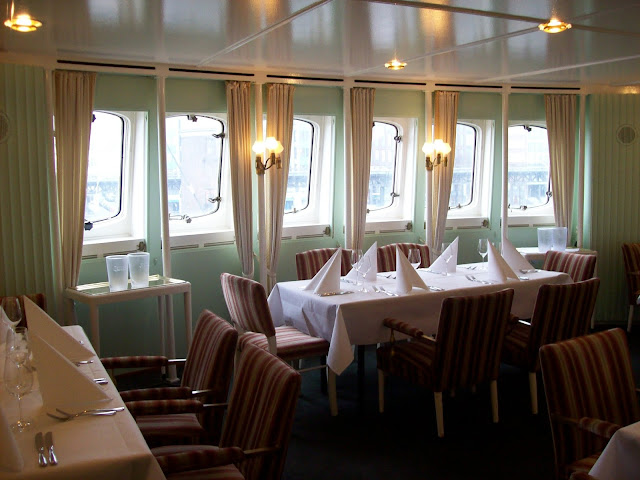

CAP SAN DIEGO dining room, midship - own photography
CAP SAN DIEGO dining room sitting area, midship - own photography
CAP SAN DIEGO Bar, Starboard - own photography
CAP SAN DIEGO Bar, starboard - own photography
CAP SAN DIEGO double cabin - own photography
CAP SAN DIEGO single cabin - own photography
The CAP SAN vessels had to leave the fleet of HAMBURG-SÜD with the advent of the containers and the dramatic change in transport. When in old and CAP SAN vessels days 350 tallymen unload a ship of theirseize within 3 days, which was rather fast, a modern day container vessel is only hours in port.
A few enthusiasts heard of the sale offer of the last remaining CAP SAN vessel - CAP SAN DIEGO. They joined forces with others and bought the near wreck and restored it to its former glory - including some minor changes. Now it is a classified (GERMANISCHER LLOYD) vessel moored in Hamburg, and is used as a floating museum, hotel and event location.
If you stay in Hamburg, try it and sleep as if you would are being transported in comfort on South Atlantic.






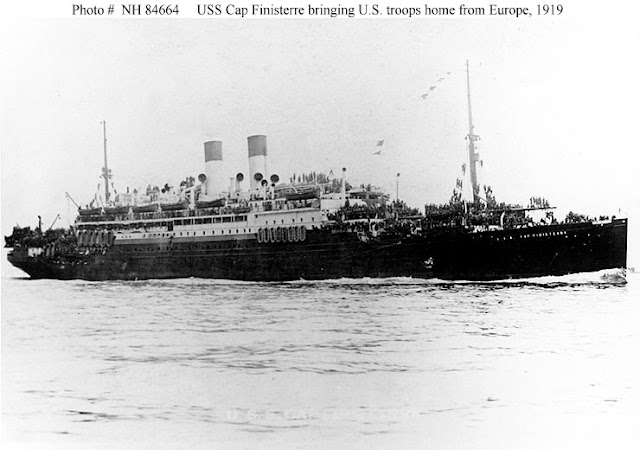




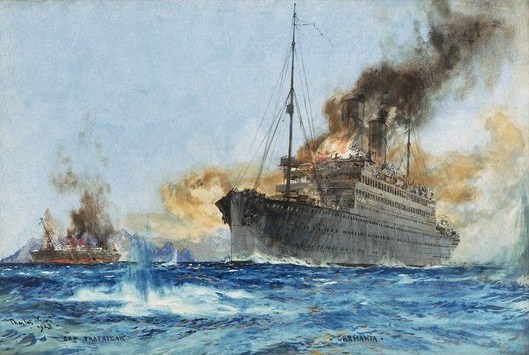
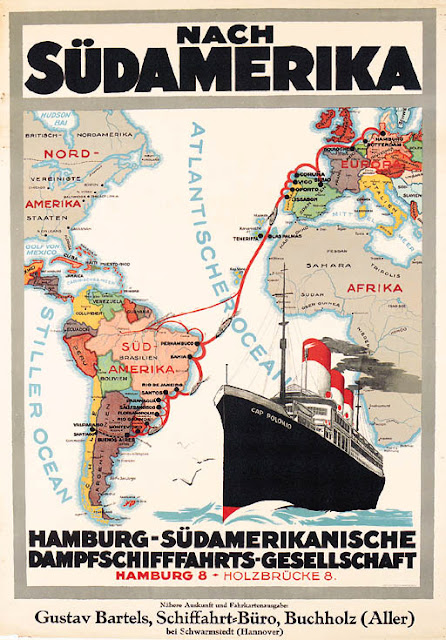




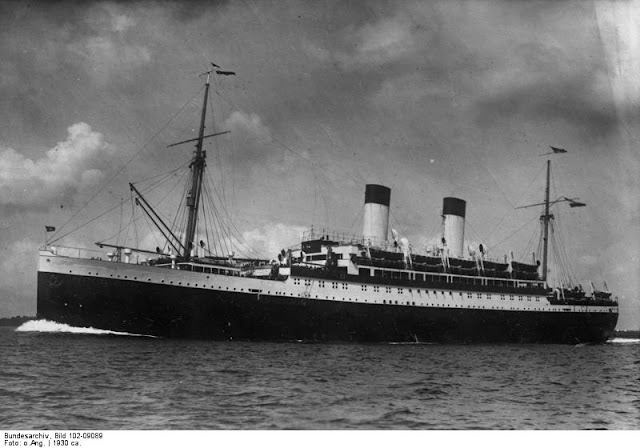
















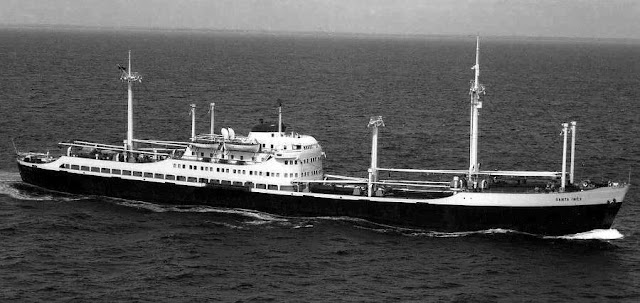


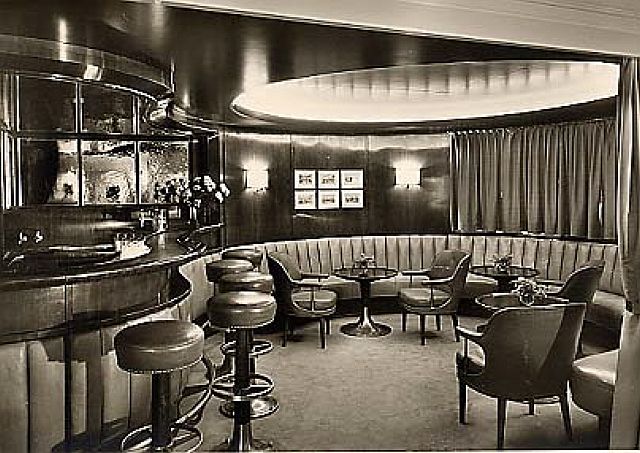







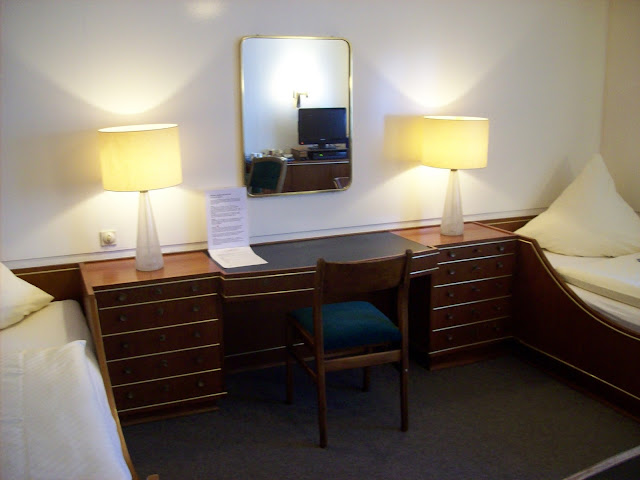
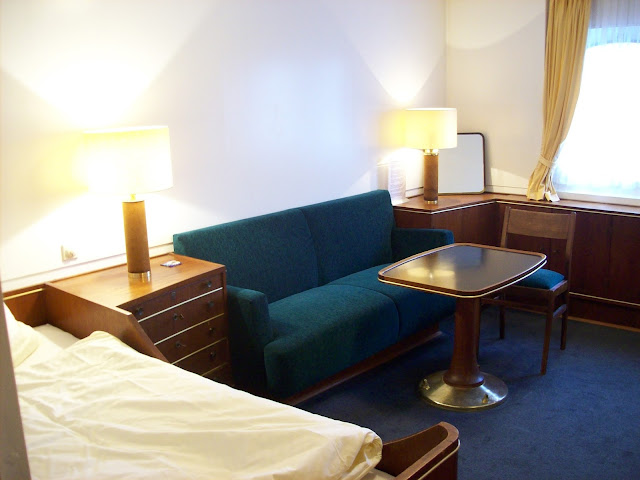
Nice work Man! So if you need a font for work operations then use this;
ReplyDeleteRoyalty Free Fonts
Great site! Love the Arms. Do you know if any of these ships ever sailed to Chile?
ReplyDelete